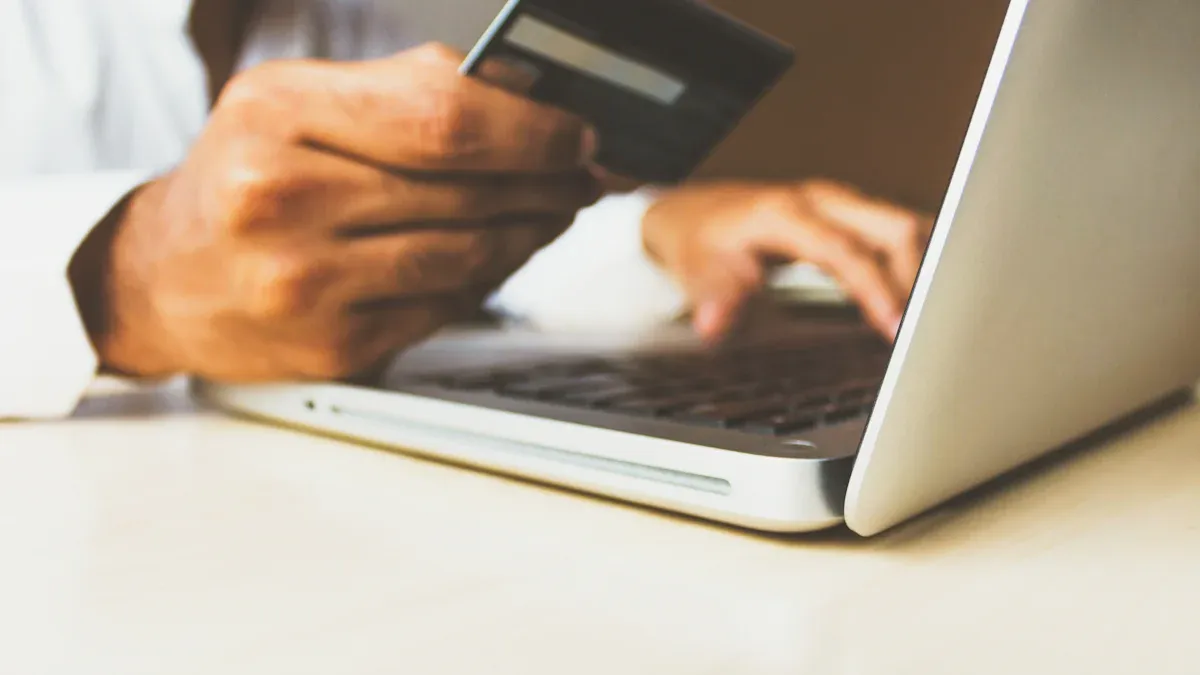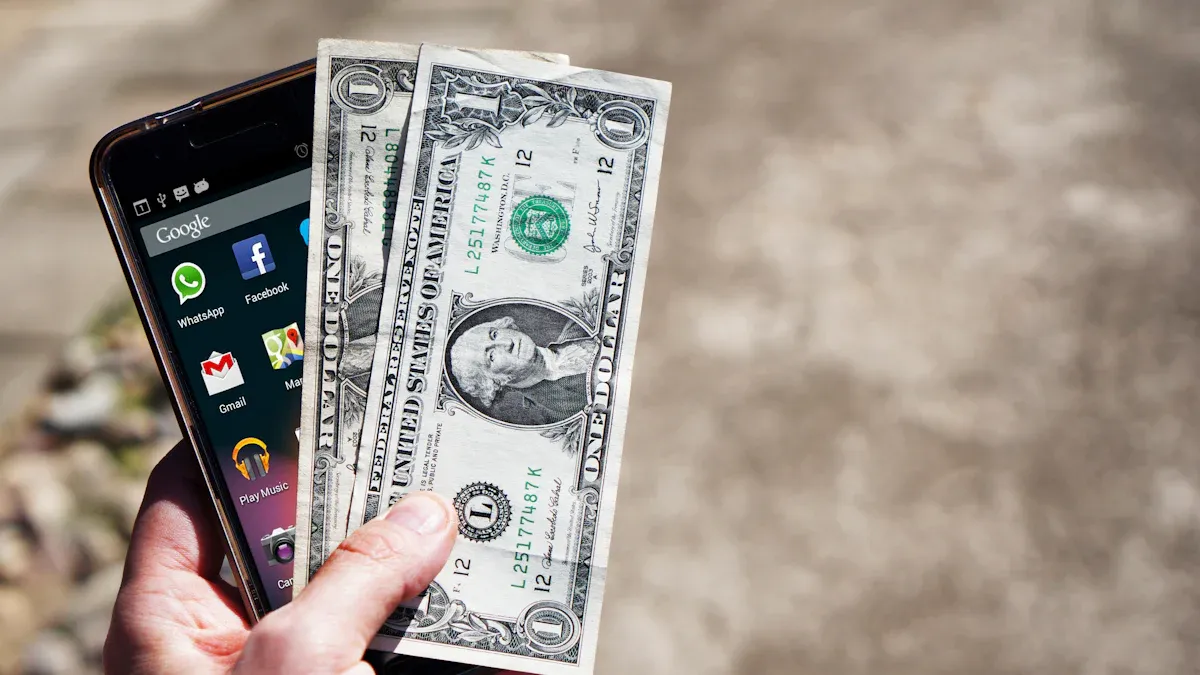- EasyCard
- Trade
- Help
- Announcement
- Academy
- SWIFT Code
- Iban Number
- Referral
- Customer Service
- Blog
- Creator
How to Remit Money to Yourself? A Safe and Convenient Guide to Fund Transfer

Image Source: unsplash
Are you wondering how to send money to yourself through a remittance? This is actually a very common need in personal financial management. In mainland China, fund management has become highly digitized. A survey shows that approximately 83% of bank customers use mobile apps to manage personal finances.
Did You Know? The demand for cross-border fund transfers is also growing rapidly. China’s digital remittance market is expected to achieve a 21.2% compound annual growth rate, indicating an increasing need for efficient global fund transfer solutions.
Choosing the right method can make your fund transfer process safer and more efficient.
Key Takeaways
- In mainland China, you can use mobile banking apps, Alipay, or WeChat Pay to transfer funds, and they are all very convenient.
- Mobile banking app transfers are typically free, while Alipay and WeChat Pay may charge a small transaction fee for withdrawals to bank cards.
- For cross-border remittances, online platforms are faster, cheaper, and more transparent than traditional bank wire transfers.
- Before transferring, compare exchange rates and fees across platforms, as some hide additional costs in the exchange rate.
- Whether domestic or international, always use official channels, enable two-factor authentication, and stay vigilant against scams to protect your funds.
Domestic Fund Transfers: Common Methods

Image Source: unsplash
In mainland China, transferring funds between accounts is supported by several mature and convenient methods. Depending on your specific needs, such as transfer amount, need for cash, or operational preferences, you can choose the most suitable option.
Mobile Banking App Transfers
If you want to transfer funds between your different bank accounts, mobile banking apps are undoubtedly the top choice. Today, most banks are focused on improving their online service experience.
Operational Tip: Simply download and log into the official app of your bank card, use the “Transfer” function, enter the recipient’s bank card number and name, and complete the process. The entire operation typically takes minutes, with funds arriving in real-time or shortly after.
The biggest advantage of this method is its cost-effectiveness and efficiency. Many banks have eliminated interbank transfer fees for mobile banking to encourage online usage.
- Major banks, including Industrial and Commercial Bank of China and Bank of China, offer free interbank transfers via their mobile apps.
- This means that even if your funds are spread across different banks, you can consolidate them onto one card at zero cost, greatly facilitating personal financial management.
Alipay and WeChat Pay
As the most popular third-party payment tools in mainland China, Alipay and WeChat Pay are not only used for daily purchases but also powerful tools for solving the question of how to send money to yourself. You can link multiple bank cards to the same payment account for flexible fund transfers.
However, when withdrawing funds from the app’s balance to a bank card, be aware of related service fees.
| Platform | Free Withdrawal Quota | Fees for Exceeding Quota |
|---|---|---|
| WeChat Pay | Lifetime 1,000 CNY free withdrawal quota per ID | 0.1% of withdrawal amount, minimum 0.1 CNY per transaction |
| Alipay | Shared 20,000 CNY free withdrawal quota across multiple verified accounts per ID | 0.1% of withdrawal amount, minimum 0.1 CNY per transaction |
Additionally, to ensure financial system stability and security, these platforms have transfer limits. Below are some common limits for Alipay personal accounts:
For users with international bank cards, limits differ:
In terms of security, you can fully trust these mainstream platforms. They employ multiple technologies to protect your funds.
- Multi-Factor Verification: Both Alipay and WeChat Pay support facial recognition, fingerprint payments, and passcodes. In some cases, the system may require a phone verification code for secondary confirmation to ensure it’s you.
- Security Technology: Alipay uses digital certificates and payment shields to ensure the confidentiality and integrity of data transmission.
- Risk Control: Both platforms have robust risk control systems to monitor unusual transactions in real-time, effectively preventing account misuse.
ATM Cash Deposits and Withdrawals
If you need to deposit cash from one account to another, ATMs (Automated Teller Machines) provide a direct physical solution. This is a traditional method for how to send money to yourself, especially for handling physical cash.
The process is simple: withdraw the required cash from one bank card’s ATM, then deposit it into another card’s ATM or all-in-one deposit/withdrawal machine. Be mindful of ATM deposit and withdrawal limits.
- In mainland China, the daily ATM withdrawal limit is typically 20,000 CNY.
- The single-transaction withdrawal limit is generally 2,500 CNY.
- Daily cash deposit limits vary by bank, with some deposit machines allowing up to 20,000 CNY daily.
Interbank withdrawals typically incur fees, usually between 20 and 30 CNY. For cross-border transactions, such as using ATMs in different regions, the fee structure is more complex.
However, some banks offer preferential policies. For example, using certain Hong Kong-issued debit cards at ATMs of the same banking group in mainland China may waive fees.
Automatic Transfers and Fund Consolidation
For users with regular financial management needs, such as monthly savings or consolidating funds from smaller accounts into a main account, setting up automatic transfers is a “set-and-forget” solution. Platforms like Alipay offer a “scheduled transfer” feature to pre-set transfer plans.
You can follow these steps to set up an automatic transfer task:
- Find the Tool: In the Alipay app, go to the “Transfer” page, find and tap the “Schedule” tool (usually a calendar icon).
- Enter Details: Select the recipient account (another Alipay account or bank card) and enter the transfer amount.
- Set Frequency: Choose “one-time” transfer or set it to “recurring” for periodic transfers, such as weekly or monthly on a specific day.
- Set Duration: For recurring transfers, set an end date or let it run indefinitely.
- Confirm Creation: Agree to terms, complete security verification, and successfully create your automatic transfer plan.
Once set, the system will automatically execute transfers on the specified dates, streamlining fund management without manual intervention each time.
Cross-Border Scenarios: How to Send Money to Yourself

Image Source: pexels
When your funds are spread across different countries or regions, how to send money to yourself becomes a more challenging task. Whether managing overseas income, paying for study abroad expenses, or transferring funds between accounts in different countries, you need a reliable cross-border remittance solution. This typically involves two main options: traditional bank wire transfers and modern online remittance platforms.
Traditional Bank Wire Transfers vs. Online Platforms
Your choice directly impacts transfer costs, speed, and convenience.
Traditional Bank Wire Transfers: Banks process international transfers via the SWIFT (Society for Worldwide Interbank Financial Telecommunication) network. This method is well-established, with the major advantage of reliability and support from physical branches, offering peace of mind for large transactions. However, its drawbacks are equally clear:
- Slower Speed: A SWIFT transfer typically takes 1-5 business days to arrive.
- High Fees: The fee structure is complex, including fixed wire fees, potential intermediary bank fees, and unfavorable exchange rate markups.
Online Remittance Platforms: In recent years, platforms like Wise and Remitly have offered more modern solutions. They often bypass the traditional SWIFT network, using innovative technology to connect local bank accounts globally for more efficient transfers.
- Faster Speed: Many transfers complete in minutes or hours.
- Transparent Fees: Clear fee structures with exchange rates closer to the mid-market rate, ensuring you know where your money goes.
- Convenient Operation: Complete all steps via a mobile app or website, no need to visit a bank branch.
Cost Comparison: $1,000 Transfer to China The table below clearly shows the fee differences. Using online platforms for bank account transfers is significantly cheaper than traditional bank wires.
| Transfer Method | Fee Range ($1,000 Transfer) | Additional Fees/Notes |
|---|---|---|
| Traditional Bank Wire (SWIFT) | $30-$60 fixed fee | 2-4% exchange rate markup, intermediary banks may deduct $10-$30, receiving bank may charge an incoming fee |
| Online Platforms (MTO) | ||
| - Bank Account Funding | $5-$15 | |
| - Debit/Credit Card Funding | $40-$75 |
In terms of delivery speed, online platforms also excel.
| Service Provider | Estimated Transfer Time |
|---|---|
| Bank (via SWIFT) | 1-5 business days |
| Wise | Seconds to 2 business days |
| Remitly (Express) | Within minutes |
| Remitly (Economy) | 3-5 business days |
Did You Know? Many of Wise’s transfers complete in 20 seconds, thanks to its smart technology that bypasses the slow SWIFT network. Remitly offers different speed options, allowing you to balance cost and timing.
General Steps for Cross-Border Transfers
Regardless of the online platform, the process is similar and user-friendly. Typically, follow these steps to complete a transfer:
- Register and Verify Account: First, create a free personal account on the platform’s website or app. You may need to provide identification documents (e.g., passport or driver’s license) to complete verification.
- Enter Transfer Details: Select the destination country and transfer amount. Then, choose the receiving method, such as direct deposit to your own bank account.
- Provide Recipient Details: Accurately enter your details as the recipient. For bank transfers, this typically includes:
- Your full name and address
- Your bank account number or IBAN (International Bank Account Number)
- The receiving bank’s name and address
- The bank’s SWIFT/BIC code
- Secure Payment: Choose a payment method to fund the transfer, such as a debit card, credit card, or direct transfer from another bank account.
- Confirm and Track: After payment, you’ll receive a confirmation email with a tracking number (e.g., MTCN). Use this to track your funds’ status until they safely reach your receiving account.
Focus on Exchange Rates, Fees, and Limits
The final cost of a cross-border transfer is determined by three key factors: exchange rate, fees, and limits.
Exchange Rate: Beware of Hidden Markups Many traditional banks and remittance providers offer rates that aren’t the true “mid-market rate” but include a markup. This difference is a hidden fee. For example, if the market rate is 1 USD to 7.12 CNY, they might offer only 7.05. For large transfers, this gap becomes significant.
Operational Tip: Before transferring, use tools like Wise or Xe to compare real-time exchange rates and total fees across providers to ensure the best deal.
The chart above shows that comparing only transfer fees or received amounts can be misleading. You need to consider both the exchange rate and fees to calculate the “total cost.”
Fees: More Than Just a Transfer Fee Beyond the stated transfer fee, you may encounter these hidden costs:
- Intermediary Bank Fees: When using the SWIFT network, funds may pass through one or more “intermediary banks,” each potentially deducting $15-$50 in processing fees.
- Receiving Bank Fees: Your receiving bank may charge an incoming fee for international transfers.
- Payment Processing Fees: If funding the transfer with a credit card, the card issuer or payment gateway may charge additional fees.
Limits: Comply with Regulations Countries impose foreign exchange limits for regulatory purposes. For example, per China’s State Administration of Foreign Exchange (SAFE) regulations:
Chinese residents have an annual personal foreign exchange quota of $50,000. When transferring and converting funds to your mainland China account beyond this limit, you’ll need to provide additional documentation to the bank.
However, for specific cases like paying for tuition or overseas medical expenses, you can apply to exceed this limit with relevant proof.
Ensuring Compliance and Account Security
Fund security is paramount in cross-border transfers. Ensuring every transaction complies with regulations is equally important.
Protect Your Account
- Use Official Channels: Always operate through official websites or apps, and never click on suspicious email or text links.
- Enable Two-Factor Authentication (2FA): Set up 2FA for your remittance account. Compared to SMS codes, using authenticator apps like Google Authenticator or physical security keys like YubiKey offers higher protection.
- Beware of Phishing Scams: Scammers often impersonate friends or institutions, citing “urgent help” or “lottery wins” to trick you into transferring money. Never send money to untrusted strangers, as advised by Washington’s Attorney General.
Ensure Transaction Compliance Cross-border fund flows are tightly regulated for tax and financial compliance.
- Tax Reporting: In the U.S., banks must report international wire transfers over $10,000 to the IRS. If your overseas financial accounts exceed certain thresholds (e.g., $50,000 at year-end), you must file specific forms (e.g., Form 8938) during tax season. Failure to comply may result in hefty fines.
- Adhere to Forex Regulations: Strictly follow foreign exchange rules, such as China’s $50,000 annual personal conversion quota, to ensure your transfers are legal and compliant.
With careful planning and the right tools, managing funds across borders can be simple and efficient.
You now have a clearer plan for how to send money to yourself. In mainland China, prioritize payment apps that hold over 90% market share. For cross-border transfers, online platforms can reduce costs from 4%-18% for traditional banks to 2%-5%.
Safety is the top priority. Always use official channels and verify the legitimacy of financial institutions using tools like the U.S. FDIC’s BankFind.
We hope this guide helps you make the most informed choices based on your needs.
FAQ
How Do I Find the Cheapest Transfer Method?
Always compare the total cost. Use online comparison tools to check transfer fees and exchange rates. A low fee may hide a poor rate. A thorough check ensures the best deal.
What If My Transfer Exceeds the Annual Limit?
The annual $50,000 limit applies to personal foreign exchange conversions.
For legitimate needs like tuition, you can apply for a higher limit. You must provide documents like admission letters or bills for bank approval.
Can I Transfer from a Hong Kong Bank Account to My Mainland China Account?
Yes, this is a common operation. You can use a Hong Kong bank’s wire transfer service or a regulated online remittance platform. Online platforms typically offer better rates and lower fees, making them more cost-effective.
Why Is the Rate I Get Different from Online Rates?
The online rate is the “mid-market rate,” a wholesale rate. Banks and remittance providers add a markup for profit. This spread is a hidden cost, so always focus on the final amount received.
*This article is provided for general information purposes and does not constitute legal, tax or other professional advice from BiyaPay or its subsidiaries and its affiliates, and it is not intended as a substitute for obtaining advice from a financial advisor or any other professional.
We make no representations, warranties or warranties, express or implied, as to the accuracy, completeness or timeliness of the contents of this publication.




Contact Us
Company and Team
BiyaPay Products
Customer Services
is a broker-dealer registered with the U.S. Securities and Exchange Commission (SEC) (No.: 802-127417), member of the Financial Industry Regulatory Authority (FINRA) (CRD: 325027), member of the Securities Investor Protection Corporation (SIPC), and regulated by FINRA and SEC.
registered with the US Financial Crimes Enforcement Network (FinCEN), as a Money Services Business (MSB), registration number: 31000218637349, and regulated by FinCEN.
registered as Financial Service Provider (FSP number: FSP1007221) in New Zealand, and is a member of the Financial Dispute Resolution Scheme, a New Zealand independent dispute resolution service provider.




















